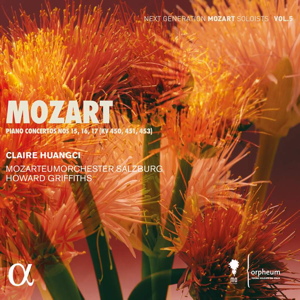
Wolfgang Amadeus Mozart (1756-1791)
Next Generation Mozart Soloists Volume 5
Piano Concerto No.16 in D major KV.451 (1784)
Piano Concerto No.15 in B major KV.450 (1784)
Piano Concerto No.17 in G major KV.453 (1784)
Claire Huangci (piano)
Mozarteumorchester Salzburg/Howard Griffiths
rec. 2021, Orchesterhaus Salzburg, Austria
Alpha Classics 928 [72]
Since 1990 the Orpheum Foundation has been bringing together young soloists and mature, experienced conductors and orchestras; in their thirtieth year they initiated the Next Generation Mozart Soloists edition which will ultimately encompass all of Mozart’s solo concertos. In this fifth installment the stage is given over to one soloist, Claire Huangci, and three piano concertos written in 1784. The conductor here is Howard Griffiths, the artistic director of the Orpheum Foundation and the orchestra is the Mozart Orchestra Salzburg, an ensemble founded in 1841 by the composer’s widow and family. Young soloist Huangci may be but she has several recordings under her belt including CDs of Bach, Scarlatti, Rachmaninov, Chopin, ballet suites of Tchaikowsky and Prokofiev as well as chamber recordings. This is not her first collaboration with Howard Griffiths; they recorded the piano version of Beethoven’s Violin Concerto for Klanglogo (KL1521 review).
The two concertos K.450 and K.451 were written for Mozart himself and they are light-hearted works full of intricate passagework, all designed to show off the twenty eight year old virtuoso in the best light as he conquered Vienna, the land of pianos as he described it. Huangci enjoys these to the fullest and her playing is effervescent and extrovert. Indeed my first thoughts on hearing this for the first time were of youthful ebullience and the sheer joy of playing. All the tempo are on the brisk side but her dazzling fingerwork still allows the passagework to breathe and there is plenty of light and shade; just listen to the development section of K.450 or indeed any of the cadenzas. Huangci chooses Mozart’s own cadenzas including the mini cadenzas in the finale of K.450 as well as some subtle turns of her own, noticeably the delicious and tasteful arabesque in her opening entry of K.450. It is in these concertos that Mozart first introduced brass and additional wind, both shown off in martial mood in K.451 which opens the disc but another first is his use of variation form in his piano concertos. The variation finale of K.453 is deservedly well known but the form is first heard in the slow movement of K.450 where Mozart does not change tempo and mood, rather he has orchestra and soloist conducting a conversation where the figuration grows on each iteration of the opening theme. The sound of the Mozarteumorchester Salzburg is almost baroque in this slow movement and their buoyant playing throughout perfectly matches Huangci exuberance.
Unlike the two earlier concertos the G major concerto was written not for himself but for his pupil Babette Ployer though there seems some doubt as to whether the premiere was given by Ployer or Mozart. Mozart was certainly present when Ployer performed it in June 1784 as the concert also included Mozart and Ployer performing the Sonata in D K.448. For all the quality of the earlier concertos Mozart seems to have brought melody, drama, colour and imagination together here in abundance and Mozart must have been eager to be the one to introduce this fabulous new work to the Viennese concert goers. The giant leap forward can be heard in the dramatic second movement, its themes seemingly so simple but with a harmonic structure that is startling each time I hear it; moments such as the modulation from G sharp major to C major, dramatic but sounding so natural. Huangci’s clean lines and unmannered style here is marvellous as is her judicious use of decorative material when called for. The sudden entry in D minor is almost heartbreaking here with moments to match it in the cadenza and Huangci finds plenty of colour for the contrasting moods found throughout the movement. Once again she is sparkling and fearless in the outer movements; I found myself applauding at the end of the finale. Gorgeous sound, perfect balance and joyful playing make this a winning recording of these three spectacular concertos.
Rob Challinor
Help us financially by purchasing from





















